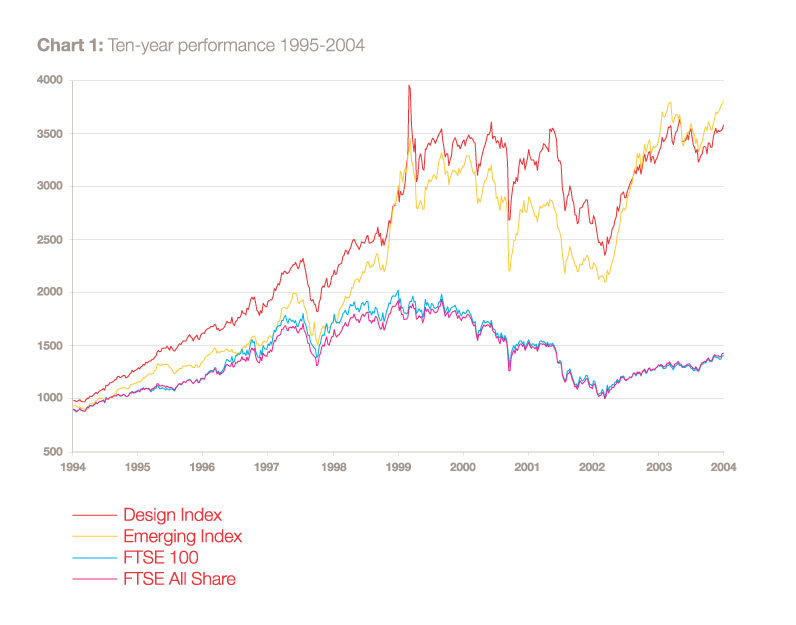The value of design
How do you know that investing in design is good for business?
This is a pretty broad question, design covers a huge and varied number of ways in which you can invest in your business. In this article we will be looking at general trends comparing businesses that invest in design against those who do not. The fastest growing, most successful companies in the world invest heavily in design, and these are the companies most able to measure that return on investment, so why do they consider it to be worth it? We look at the stats behind design investment and explain why and how investing in good design can pay for itself.
Ways to measure ROI
Some design projects can return tangible, easy to measure results. These might include an advert in a magazine, an email campaign or a re-design of a website payment interface. To measure the effect these projects have, you can simply compare before and after sales numbers. Other projects can be more long term and contribute to the sustained growth of your business. A new brand, for example, is unlikely to have an immediate impact on your bottom line. No customer is going to walk through your door and tell you they bought your product after seeing the lovely logo. These are more long term strategies and investments for your business. Fortunately there is substantial research into the affects of design investment and below we have taken some of the key points from the Design Council factfinder report.
Headline stats
These points are taken from the Design Council report and highlight the most relevant stats for businesses to consider when deciding to invest in design.
Every £100 spent on design increases turnover by £225.
When businesses invest in design, they spend less time needing to compete with their rivals on price.
Shares in design-led businesses outperform key stock market indices by 200%.
Design alert businesses increase their market share by 6.3% through investment in design.
Businesses that invest in design increase their chances of turnover growth, while those that decreased investment cut their chances of growth.
Two thirds of UK businesses believe that design is integral to future economic performance.
Rapidly growing businesses are nearly six times more likely than static ones to see design as integral.
Rapidly growing businesses are twice as likely as the UK average to have increased investment in design.
The Design Council created a design index made up from 61 design led businesses to track how well they performed compared to the FTSE 100.
First impressions count
Studies have shown that the first impression a potential customer forms about your business are 94% design-related. One way in which this can be measured is through website design. When a potential customer arrives at your website, they form an opinion about your business almost instantly. 75% of users form an opinion on a company’s credibility based solely on its website design while 88% of users are unlikely to return if the user experience on that website has been poor.
You may have visited websites yourself in which you have hesitated or decided not to purchase a product or service based on the look of the website. We quickly form opinions on trust, reliability and quality, sometimes without really knowing why. This is why it is so important to, not only attract customers, but to avoid actively putting them off choosing you in those first vital seconds.
Rapid growth
Attracting new customers by encouraging them to stay on your website, purchase your product or walk through your shop door means you’ve made that first step to growing your business. The next is to hold onto them. Making your brand memorable, communicating the right message and standing out from the competition will give you a competitive edge, bring them back and build loyalty. When you can do this, your business will grow rapidly. Of all businesses in the UK who are considered to be growing rapidly, only 1 in 10 don’t use design.
How can you use design to encourage growth?
Refine your brand to stand out from the competition and keep your visual messaging consistent
Create better presented and more visually engaging social media content
Perfect a professional looking pitch deck to promote your services and skills
Ensure your website is engaging with a seamless user experience
Eye-catching and convincing advertising campaigns
Beautiful marketing material that engages readers and converts
Summary
Designers are not usually business orientated, and 40% admit to being unable to explain the value of the service they provide. We all know that good design is beneficial to business in the short and long term, in the same way photography, copywriting or illustration can be. Why else would the most successful companies in the world invest so much in their websites and brands? But for small and medium sized businesses, this can be hard to measure and often requires a willingness to invest in the long term and sustained growth of their company. On average it takes 20 months for a design project to pay back the investment. But research shows that design increases turnover. For every £1 invested in design, businesses can expect over £20 in increased revenues




